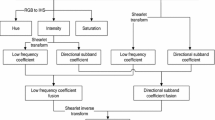Abstract
A new method of remote sensing image fusion is proposed based on the second generation Curvelet transform and Dempster-Shafer (DS) evidence theory. In this paper, the remote sensing images are decomposed by the Curvelet transform to get the coefficients and optimize the high coefficients with DS evidence theory. Firstly, the high resolution and multispectral remote sensing images are decomposed by the Curvelet transform to get the Curvelet transform coefficients of all layers (Coarse, Detail and Fine scale layer). Secondly, the Coarse scale layer is used the maximum fusion rule. The Detail scale layer is used by the weighted average fusion rule. The Fine scale layer is optimized by the DS evidence theory. Get the three features of the Fine scale layer coefficients. The three features are the variance, information entropy and energy. Use the features to be some parameters belief function and the plausibility function. Then compose the mass function and get new fusion coefficients. Finally, the fused image is obtained by the inverse Curvelet transform. The experimental results show that the new algorithm can more effectively than wavelet and other traditional fusion algorithms such as HIS, brovey in the remote sensing image fusion.



Similar content being viewed by others
References
Candes, E., Demanet, L., Donoho, D., et al. (2006). Fast discrete Curvelet transforms. Multiscale Modeling & Simulation Journal, 5(3), 861–899.
Lu, Y., Guo, L., & Li, H. (2012). SAR and MS image based on Curvelet transform and activity measure. Journal of Application Reserch of Computers, 29(11), 4360–4363.
Wang, H., Peng, J., & Wu, W. (2003). Application of the information fusion based on evidence theory in image classification. Journal of Computer Engineering & Applications, 39(33), 11–14.
Wei, F., & Wenxing, B. (2012). A new technology of remote sensing image fusion. TELKOMNIKA, 10, 551–556.
Yan, N., & Licheng, J. (2007). Image fusion algorithm based on multi-resolution analysis theory [M] (pp. 191–192). Xi’an: Xi’an University of Electronic Science and Technology Publishing House.
Yan, J., & Quxiao, B. (2008). Beyond wavelets and its applications (pp. 13–30). Beijing: National Defense Industry Press.
Yao, L., Zhao, H., Luo, B., & Zhu, Z. (2012). Medical image fusion with multi-feature based on evidential theory in wavelet domain. Journal of Computer Applications, 32, 1544–1547.
Zhang, Y., Wang, P., & Zhang, G. (2008). An information fusion approach and its application based on D-S evidence theory and neural network. China Control Conference, 6(16-18), 623–626.
Zhao, X. (2012). Remote sensing image fusion based on second curvelet and PCA transform. Journal of Science Technology and Engineering, 12, 581–585.
Acknowledgments
This work is supported by National Natural Science Foundation of China (61162013), the Independent research foundation of Beifang University of nationalities (2011SDJ007), the planned science and technology Project of Ningxia Province under Grant 2010 year, the scientific research projects of State Ethnic Affairs Commission (12BFZ009).
Author information
Authors and Affiliations
Corresponding author
About this article
Cite this article
Huang, C., Bao, W. A Remote Sensing Image Fusion Algorithm Based on the Second Generation Curvelet Transform and DS Evidence Theory. J Indian Soc Remote Sens 42, 645–650 (2014). https://doi.org/10.1007/s12524-013-0359-z
Received:
Accepted:
Published:
Issue Date:
DOI: https://doi.org/10.1007/s12524-013-0359-z




